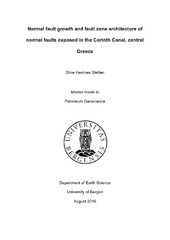Normal fault growth and fault zone architecture of normal faults exposed in the Corinth Canal, central Greece
Master thesis
Permanent lenke
https://hdl.handle.net/1956/12783Utgivelsesdato
2016-08-22Metadata
Vis full innførselSamlinger
- Department of Earth Science [1103]
Sammendrag
The Corinth Canal in central Greece consists of an excellent natural transect across a population of normal faults. This study presents a structural analysis of 23 exposed faults, focusing on fault geometry, fault zone architecture and the structural evolution of the Corinth Canal. The canal is located on the Corinth Isthmus in the eastern part of the Corinth Rift, which is one of the most active continental rifts on Earth. Main structural elements exposed within the canal section are a central horst block, several fault blocks and the Isthmia Graben. The study integrates traditional field data with LiDAR-based digital outcrop data. The quantitative fault analyses conducted include fault orientations, throw-depth plots, expansion indices and cumulative plots of fault frequency, throw and heave. A detailed stratigraphic framework is provided in order to determine the relative timing and growth history of the studied faults. The stratigraphy of the Corinth Canal is divided into six tectonostratigraphic units based on the identification of major erosional surfaces, major shifts in facies and thickness trends that can be related to tectonic events. Tectonostratigraphic Units 1, 2 and 3 are composed of lacustrine deposits, whereas Tectonostratigraphic Units 4, 5 and 6 are composed of marine deposits. The faults exhibit planar, listric or vertically and laterally segmented geometries. The vertically segmented geometries include contractional overlaps, contractional and extensional bends, hard linked structures and lenses. Damage zones are commonly narrow and contain splay faults and smaller scale faults. The distribution of faults, throw and heave within the Corinth Canal is moderately heterogeneous with localization of strain onto several larger faults and in the half graben SE of the central horst. Most of the strain is accommodated by the horst-bounding faults. The exposed faults are interpreted to represent the up-dip tip of deep-seated faults that have nucleated at depth. Their growth history is characterized by blind fault propagation before breaching the surface and becoming syn-sedimentary growth faults. Burial and inactivity also characterize the history of several faults; some of which show signs of polycyclic growth. An age model for the key stratal surfaces that bound the marine tectonostratigraphic units is proposed based on previously dated Acropora corals within the canal section and the chronostratigraphy of the Corinth Gulf. This allowed to constrain the activity of the N- and S-dipping faults between 620 ka to 340 ka, which is consistent with observations from the offshore Corinth Gulf; thereby linking the structural evolution of the Corinth Canal with the regional evolution of the Corinth Rift.
